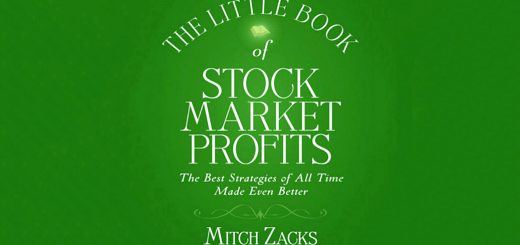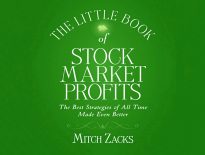Stock Market Profits 3 – IPOs, Buybacks, Accruals and Valuation

Today’s post is our third visit to The Little Book of Stock Market Profits by Mitch Zack. Today we’re going to look at IPOs, share buybacks, accruals and valuation.
IPOs
Mitch is not a big fan of IPOS.
- We agree – see Don’t Invest in IPOs.
The only IPOs you want to buy are those that you have trouble getting access to. The IPOs that are actually offered to you are the ones you want to take a pass on.
There are negative excess returns following an IPO, as well as positive excess returns following share repurchases and dividend increases.
If a company wants to sell you stock, take a pass. And if a company wants to buy stock from you, the best course of action is not to sell.
In theory, companies should go public when their growth prospects are such that cash is not available from the usual sources.
In practice, companies go public in order to make money for their current shareholders.
Mitch quotes a study that looked at 1,500 IPOs, which generated an average -30% over the next 36 months.
- IPOs are usually small companies in high-growth industries, but even after matching them to similar firms, they still underperform.
- Investors appear to too optimistic about the growth prospects of IPOs.
Somewhat surprisingly, VC-backed IPOs appear to underperform much less than those without VC backing.
Note also that secondary and tertiary offerings of equity also underperform.
It does not matter if the equity is being offered for the first, second, or third time. The stocks of companies issuing shares are more likely to be losers than winners.
Mitch recommends using the level of IPOs as a market gauge – when there are lots of IPOs, future returns from the markets will be low.
- This makes sense, because IPOs are more likely to take place when there is excess demand for equities.
The same goes for lots of secondary and tertiary offerings.
- Managers will issue equity only when they thing the public will pay more for it than they think it is worth.
Mitch admits that “stagging” (applying through the paper offer and selling after a week or so) can be profitable in theory.
- The problem is that you will end up with few shares in the profitable issues (where demand is high) and lots of shares in the unprofitable ones.
Truly successful “IPOs” may not in fact be offered to the public directly.
Buy backs
Mitch explains that there are three reasons for buy backs:
- To boost EPS by reducing the number of shares.
- To avoid double taxation of dividends.
- Because the shares are undervalued.
Mitch believes that the last reason is the most common, because buybacks are usually good news for a stock.
- A study of 1,200 buybacks showed outperformance over the following four years.
- he effect is strongest with small cap shares.
A tender offer – where the company contacts its shareholders with an offer for their shares – is an even stronger signal.
- In my experience these are used mostly by investment companies (ITs, VCTs etc) in the UK.
- Again, the tender offer effect is most pronounced in small caps.
Mitch notes that it is important that the buyback actually happen, rather than simply be announced.
Acquisitions
Companies that perform acquisitions should be avoided.
Mitch compares them to the winners of an auction, who likely overpaid.
But if the acquisition is paid for with debt, that is a signal that the company things that its equity is cheap.
- Acquisitions funded by stock are a signal that the stock is overvalued.
Dividends
As you might expect, initiating dividends has a positive impact on the share price, and cutting or suspending them (or even ending them) has a negative impact.
- The negative impact of cuts and suspensions is larger than the positive impact from initiation.
Accruals
Mitch has an earnings accruals strategy that focuses on the quality of earnings.
Few clients pay upfront with cash.
- Accruals are essentially the part of earnings that haven’t been received yet.
The strategy is based on trusting cash earnings more that accounting earnings.
- Accruals are lower quality earnings, because they might not turn up.
Mitch’s strategy looks at changes in current net operating assets:
(Current Assets - Cash) - (Current Liabilities - Short-Term Debt - Income Taxes Payable).
Accruals are the difference in net operating assets from one year to the next:
Current Net Operating Assets (End of the Year) - Current Net Operating Assets (End of Previous Year).
If accruals are increasing:
Earnings are being generated by increasing current net operating assets such as increasing inventory or accounts receivable.
The increase in earnings is deeply dependent on how the accountants are valuing current net assets, and over time the value assigned to current net assets is likely to be overstated.
Earnings due to accruals are not sustainable over longer periods of time.
Going long stocks with low earnings accrual and shorting stocks with a high earnings accrual produces a market neutral portfolio that generates double-digit annual percentage return.
The market does not know that earnings due to accruals are not sustainable and mistakenly pays up for them.
Mitch notes that the returns from the strategy have been lower since 1996.
- This reduction has been strongest in shares with high institutional ownership.
- It is also stronger in more liquid and less volatile stocks (large stocks).
Earnings accruals seem to work better in industries where working capital is a more important component of total assets: construction, toys, computers, and electrical equipment.
The strategy does not work well among drug companies, mining companies, and energy companies.
Earnings accruals seem to work relatively well as a means of avoiding companies likely to experience negative accounting events.
The best use of earnings accruals is to help you to find stocks to avoid.
Valuation
Since 1927 value stocks outperformed growth stocks in 58% of years. Several years saw outperformance of more than 20%.
Mitch likes the PE ratio as a measure of value, but accepts that price to book or cash flow multiples produce similar results.
The price-to-book ratio is the stock price divided by shareholders’ equity per share.
Book value is the difference between the accounting value of the assets of the company and the accounting value of the company’s liabilities.
The ratio can be thought of as how excited investors are about the company’s future earnings prospects.
A big point about value investing – as anyone who has been investing since the 2008 crash will realise – is that it doesn’t work all of the time.
Mitch explains the value anomaly by reference to the “hot hand” sports fans think that certain players develop.
- Lots of investors feel the same way about growth stocks.
They overemphasise recent performance (sales and earnings trends).
- Whereas in fact reversion to the mean is the most common outcome.
Value’s outperformance may be due to growth’s underperformance.
It’s also likely that investors have a preference for companies with strong fundamentals, regardless of price.
- Companies close to financial distress are difficult to justify, particularly for institutional investors.
Growth companies also tend to have a lot of favourable media coverage.
Mitch doesn’t entirely buy into the cognitive bias theory, but it works for me.
- People are greedy, and they like to be associated with glamourous growth stocks.
The value premium could also be a reward for taking on an increased risk of bankruptcy.
- Or compensation for the risk that a recession (without government intervention) becomes a depression that wipes out value stocks.
One interesting finding is that the value premium is higher for stocks with high volatility.
- The volatility appears to dissuade institutional investors from exploiting the associated value.
High spreads and low institutional ownership are other factors that increase the value effect.
- Which of course points to small caps.
Mitch particularly recommends buying value during a recession, when investors are most worried about bankruptcy.
Conclusions
It’s been another breezy spin through three more chapters of the book.
- We all know about value, and I’ve long advised people not to buy IPOs.
But I didn’t know that buybacks were so positive.
- And I don’t use earnings accrual as a negative filter.
I’ll be back in a couple of weeks with the final three chapters of the book, which look at earnings surprises, seasonal effects and building multifactor models.
Until next time.














